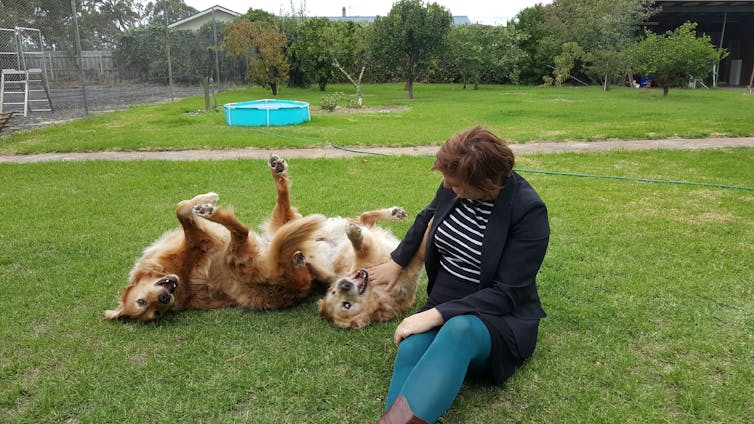Is your dog happy? Ten common misconceptions about dog behaviour
- Written by Paul McGreevy, Professor of Animal Behaviour and Animal Welfare Science, University of Sydney
It is difficult to refer to what dogs, as a collective, like and dislike and how they behave. Just as humans do, dogs all have their own personalities and learned preferences and so can differ dramatically in how they approach life and what they take from it.
In our book, Making Dogs Happy, we use scientific research, illustrative photos and practical tips to help dog owners to appreciate what their dogs may be feeling from moment to moment, and have strategies ready to respond in ways that support their dogs.
Read more: The science behind why some people love animals and others couldn't care less
Making Dogs Happy is focused on the pragmatic application of current theory to improve your relationship with your dogs and, of course, in the process make them happy.
There are many ways in which we can misjudge dogs by assuming that they are little furry humans. Here are ten common misconceptions that stem from assigning human values and needs to dogs.
1. Dogs have a human appreciation of sharing
Humans can rationalise and appreciate the benefits of sharing. In contrast, among dogs, possession is ten-tenths of the law. So we should not take toys, bones and chews away from dogs unless we have trained them to accept this form of intervention.
2. Dogs always enjoy common human physical displays of affection
Humans often show their affection for others by hugging and cuddling them. Dogs simply do not have the limbs and joints to achieve this and so have not evolved to give each other a loving squeeze. When embraced by humans, many can find this uncomfortable or threatening. The same goes for patting dogs on the head.
3. Barking and growling dogs are always threatening or dangerous
These are distance-increasing behaviours. The dogs using these signals are chiefly trying to buy space so they can feel safer. All dogs, regardless of their temperament or training, can at times want more space. They usually try more subtle signalling first, but many dogs learn that subtle signals don’t work and go straight for shouting.
4. Dogs will welcome unfamiliar dogs to their home
Dogs evolved from wolves and are therefore primed to defend what is theirs. They have an attachment to their home territory and the resources within it. Dogs have no way of knowing that the dogs and human we invite around to our home, for example for a play-date, are ever going to leave. They can be forgiven for thinking that this is the way it is going to be from hereon. So it is to be expected that they will often try to lay out the local ground-rules and put the new arrivals in their place.
 These dogs bark for joy.
Sasha Petrova
These dogs bark for joy.
Sasha Petrova
5. Dogs like relaxing as much as humans do
We go to work and go to school, so we greatly value the opportunity to chill out at home and maybe watch TV. In contrast, dogs spend most of their time at home and so value exercise off the property far more than time spent on the sofa. So, for dogs, a change is not just as good as a rest – it’s much better.
6. An effusive dog is a friendly dog
“Friendly” for one dog is not friendly for all dogs, and some dogs use excessive friendliness as a way to alleviate anxiety associated with meeting another dog or human. Owners of very friendly dogs may be surprised when every other dog does not cheerfully receive their dog. Some dogs prefer sedate greetings, and lots of personal space.
Read more: Are dogs trying to tell us something with their expressions?
7. Dogs approach when they want to engage playfully
Sometimes owners are confused when a dog approaches a human or another dog in a friendly fashion and then growls or snaps at them. These dogs may be motivated to approach chiefly to gain information, rather than to interact, and some may like strangers in principle, but nevertheless become anxious and overwhelmed all of a sudden. If you are seeing this pattern, call your dog away from new dogs and humans after a couple of seconds.
8. A big yard can replace walks
Because dogs spend so much time at home in the yard, they often find the area a little too familiar and sometimes rather dull. The size of a yard is far less important to dogs than what happens in it. Dogs truly thrive on play with each other, with us and with toys. They particularly love to do so in a novel environment, so time spent out of the yard is the very best of fun.
 Dogs do like relaxing – but not all the time.
Marta Skrabacz
Dogs do like relaxing – but not all the time.
Marta Skrabacz
9. Dogs are wilfully defiant when they don’t do as they are told
Rather than deciding to disobey us, dogs sometimes simply can’t do what we ask them to. Either they don’t actually know what we’re asking them to do, or they have much, much more pressing things to do at the time. Dogs are not great at generalising, so just because they sit nicely when asked to in the kitchen when you have treats in your hand doesn’t mean they automatically know what “sit” means when they are at the off-leash dog park.
And while your dogs might know what “sit” means when being trained at home without distractions, asking them to do so when visitors are at the door might be like asking a child to kneel and pray upon arriving at an amusement park.
Read more: Curious Kids: Why don't dogs live as long as humans?
10. Barking, snapping, or lunging is the first sign of an unhappy dog
Dogs often give subtle signs they are becoming anxious, like avoiding eye contact with whatever is worrying them, licking lips, brow furrows, lifting a paw, tightening muscles in their face. If nothing is done to help these dogs move away from whatever is worrying them, these signs can often escalate to more troubling behaviour that is more obvious, such as growling and snapping.
Paul McGreevy and Melissa Starling are launching their book Making Dogs Happy at a symposium at the Charles Perkins Centre Auditorium, University of Sydney, on Saturday June 2. Details here.
Authors: Paul McGreevy, Professor of Animal Behaviour and Animal Welfare Science, University of Sydney
Read more http://theconversation.com/is-your-dog-happy-ten-common-misconceptions-about-dog-behaviour-97541



















